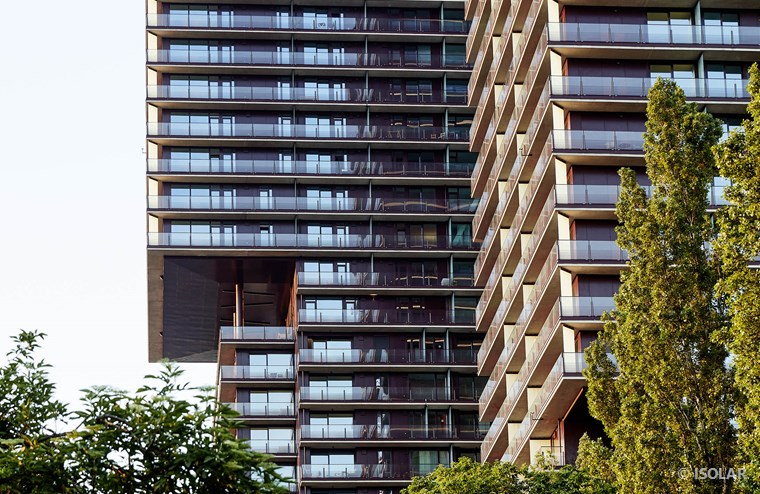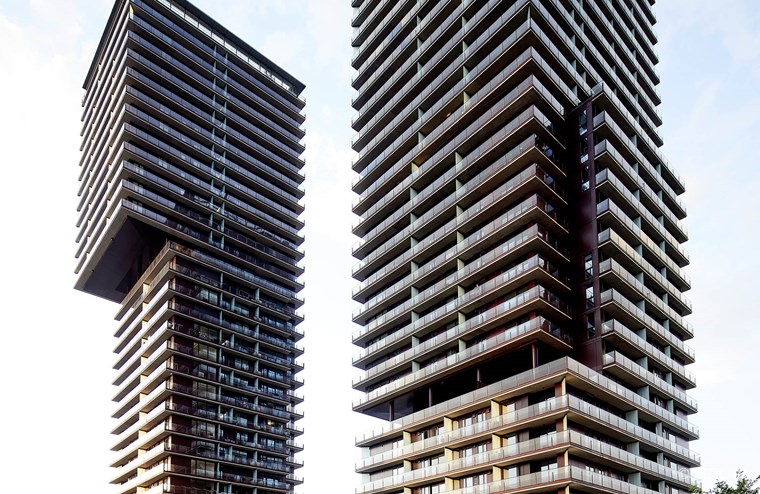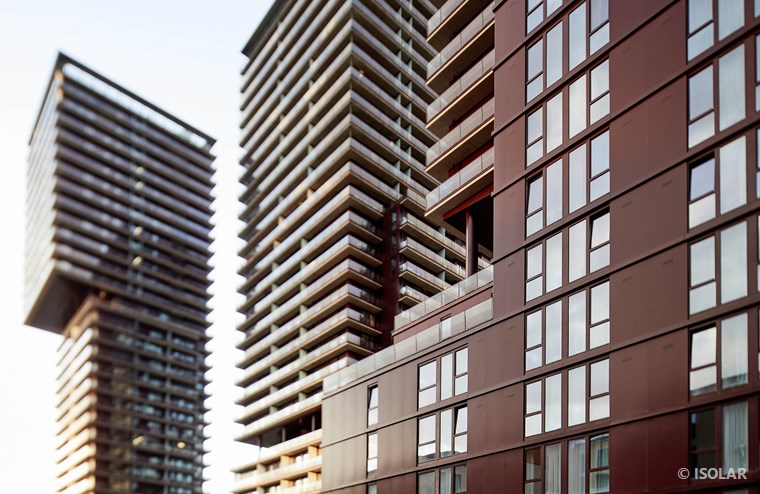TrIIIple
Glass facade provides modern appearance and sun protection
In Vienna's 3rd district, on the site of the old customs office, three imposing high-rise buildings have been built, the TrIIIple. What is special about them is not only that they combine living and working under one roof in the most modern way. The Tetris figure-like silhouette of the residential towers, each over 100 meters high, with their striking glass facades, could become a new architectural landmark of the Danube metropolis.
Vienna's cityscape is characterized by numerous Romanesque, Gothic and Baroque buildings. The Danube City Tower 1 (DC Tower 1) or the campus of the Vienna University of Economics and Business Administration, on the other hand, are representatives of architectural modernism. With the TrIIIple Vienna, the Danube metropolis has now gained yet another representative of a new architectural language. Located directly on the Danube Canal, opposite the green Prater park, the three towers, which are around 100 meters high, house more than 1,000 apartments, a library, shopping facilities, cafés and restaurants. The three buildings, which differ among other things in their structural sculptural formulation, form a significant high-rise ensemble. The concept is based on three individual buildings in dialogue with each other, each with a strong sculptural character, which is so far unique in Vienna. TrIIIple Vienna is an extension of the "TownTown" project – the largest public-private partnership project in Austria. With their cantilevers up to 15 meters deep, the three towers are figuratively reminiscent of the well-known Tetris computer game.
First construction project of this kind
The TrIIIple was developed in cooperation with the project partners Soravia and ARE Austrian Real Estate, who wanted to create new living space for the metropolis of millions. Because, like many other major cities, Vienna is currently experiencing a major influx. The city now has more inhabitants than ever before: almost 2 million. The TrIIIple is a showcase project in this respect, as it enables a new dimension in living directly on the Danube Canal. The unparalleled variety of services, including a concierge service, event kitchens, rooftop pools and a library, as well as a party and barbecue lounge, leave hardly anything to be desired by residents.
The wide range of restaurants and shops is also open to the public. According to the investor, almost all of the 33- to 165-square-meter apartments in Towers 1 and 2 have now been sold. Tower 3, the right-hand tower as seen from the green Prater, has around 670 micro apartments ranging in size from 21 to 57 square meters for students and young professionals. By covering the adjacent A 4 freeway, a park of around 4,000 square meters was created – which also serves as direct access to the Danube Canal.
Sustainability taken a step further
The immediate proximity to the green Prater and Danube Canal lends the three high-rise buildings a special charm. But that's not all: The Danube Canal also serves as a heating and cooling system for the TrIIIple. Water is piped from the Danube Canal to the technical center. There, similar to a combined heat, power and cooling system, the temperature of the heating and cooling system of the three buildings is exchanged with the Danube water. Water is taken from the Danube Canal for a short time and converted into heating or cooling. After use, the river water is returned to the Danube Canal with a small temperature difference. In this way, the buildings achieve a saving of around 2,100 tons of CO2 per year in heating and cooling production.
In order to keep energy costs fundamentally low as well as to achieve optimal thermal insulation, SOLARLUX solar control glass was installed throughout the building. These glasses also ensure a comfortable indoor climate – in all seasons. "This is achieved by a special coating applied to at least one glass surface," explains Hannes Spiss, managing director of ISOLAR GLAS Beratung. "The radiation energy of the sun consists of visible light, short-wave UV radiation as well as long-wave infrared radiation," the glass expert knows. Half of the energy arriving on the earth's surface is visible light, he says, while the other half consists mainly of infrared radiation. "The SOLARLUX coating lets the visible light into the building interior and reflects the other radiation areas back outwards," says Spiß, continuing, "This significantly reduces the risk of summer overheating. Whereas in the winter months energy can be gained and at the same time insulating low-e coatings drastically reduce heat loss."
Solar and sound insulation as a challenge
However, the requirements for thermal insulation and solar control as well as aesthetics were not the only ones that the glass had to meet. "Due to the immediate proximity to the two freeways A 4 and A 23, the glass had to meet special sound insulation criteria," explains Spiß. He also says that the structural plastic formulations in the form of the up to 15-meter-deep cantilevers were a major challenge for all the construction companies involved. "And last but not least, the large quantity of insulating glass for the facades presented us with logistical challenges," the glass expert continues. After all, a total of 4,000 square meters of Solarlux solar control glass was installed on the facades of the TrIIIple towers.
| Project partner |
SORAVIA, Town Town, Thomas-Klestil-Platz 3, 1030 Vienna, Austria ARE Austrian Real Estate GmbH, Trabrennstraße 2b, 1020 Vienna, Austria |
|
Architect |
Henke Schreieck Architekten ZT GmbH, Neubaugasse 2/5, 1070 Vienna, Austria |
|
Façade construction |
Sauritschnig Alu-Stahl-Glas GmbH, Industriestraße 2, 9300 St. Veit/Glan, Austria |
|
Glass production and delivery through the ISOLAR partner: |
"Isolar" Isolierglaserzeugung GmbH, Schwendnergasse 16, |



